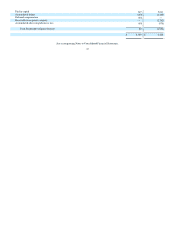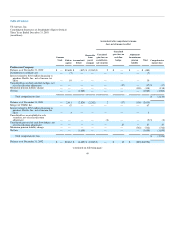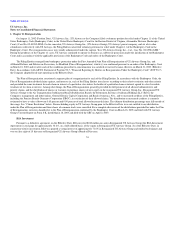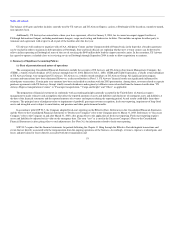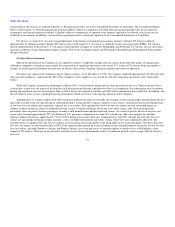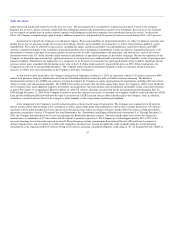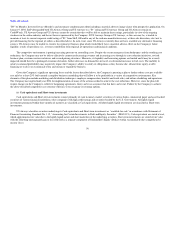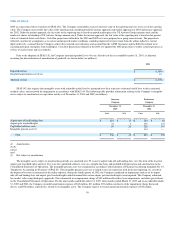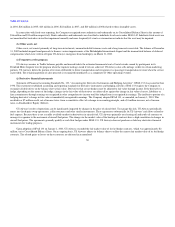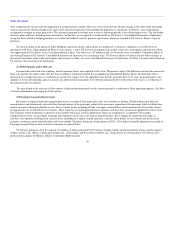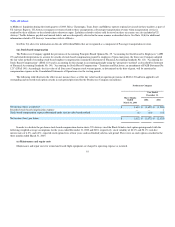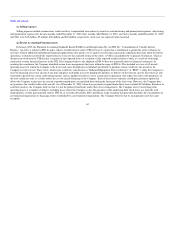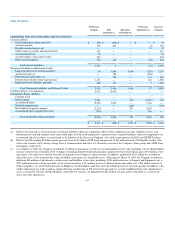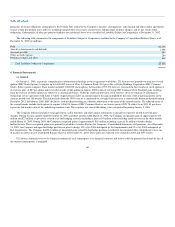US Airways 2003 Annual Report Download - page 63
Download and view the complete annual report
Please find page 63 of the 2003 US Airways annual report below. You can navigate through the pages in the report by either clicking on the pages listed below, or by using the keyword search tool below to find specific information within the annual report.
Table of Contents
"B3" by Moody's Investor Service (Moody's) and customary conditions precedent including a material adverse change clause with prospective application. On
January 9, 2004, S&P downgraded both US Airways Group and US Airways to a "B-" rating and US Airways Group and US Airways remain on
CreditWatch. US Airways Group and US Airways cannot be certain that they will be able to maintain these ratings, particularly in view of the ongoing
weakness in the airline industry and the net losses experienced by the Company. If US Airways Group or US Airways, as the case may be, is unable to
maintain at least its current corporate credit rating of "B-" from S&P, GE and/or any of the airframe manufacturers may, at their sole discretion, elect not to
provide financing for the regional jet orders as described above. In such event, since US Airways currently does not have available any alternative financing
sources, US Airways may be unable to execute its regional jet business plan which would likely have a material adverse effect on the Company's future
liquidity, results of operations (i.e., revenue contribution from regional jet operations) and financial condition.
The competitive environment is putting increasing pressure on controlling costs. Despite the recent emergence from bankruptcy and the resulting cost
reductions, the Company may not be able to effectively counteract decreasing revenues and increasing costs through its cost reduction initiatives, revised
business plan, customer service initiatives and revised pricing structures. Moreover, its liquidity and borrowing options are limited and it may be severely
impacted should there be a prolonged economic downturn, further decreases in demand for air travel or substantial increases in fuel costs. The inability to
achieve sustained profitability may negatively impact the Company's ability to satisfy its obligations as they become due, obtain future equity or debt
financing or to do so on economical terms and sustain or expand the business.
Given the Company's significant operating losses and the factors described above, the Company is pursuing a plan to further reduce cost per available
seat mile by at least 25% built around a complete business remodeling that will allow it to be profitable in a variety of competitive environments. Key
elements of this plan include marketing and distribution techniques, employee compensation, benefits and work rules, and airline scheduling and operations.
The Company has targeted mid-year 2004 for implementation of many of the actions needed to achieve the cost reductions. However, since the plan will
require changes in the Company's collective bargaining agreements, there can be no assurance that this date can be met. Failure by the Company to achieve
the above-described competitive cost structure will force it to reexamine its strategic options.
(c) Cash equivalents and Short-term investments
Cash equivalents and Short-term investments consist primarily of cash in money market securities of various banks, commercial paper and asset-backed
securities of various financial institutions, other companies with high credit ratings and securities backed by the U.S. Government. All highly liquid
investments purchased within three months of maturity are classified as Cash equivalents. All other highly liquid investments are classified as Short-term
investments.
US Airways classifies securities underlying its Cash equivalents and Short-term investments as "available-for-sale" in accordance with Statement of
Financial Accounting Standards No. 115, "Accounting for Certain Investments in Debt and Equity Securities" (SFAS 115). Cash equivalents are stated at cost,
which approximates fair value due to the highly liquid nature and short maturities of the underlying securities. Short-term investments are stated at fair value
with the offsetting unrecognized gain or loss reflected as a separate component of Stockholder's Equity (Deficit) within Accumulated other comprehensive
income (loss).
56


